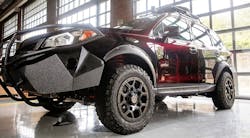Mississippi State University Develops All-Electric, Autonomous SUV
An all-electric SUV was designed by a Mississippi State University (MSU) team at its Center for Advanced Vehicular Systems (CAVS) facility. Designed to function autonomously in off-road environments, the vehicle is built with the latest automotive technology and is paving the way for advances in a key area with personal, military, agriculture, and search and rescue implications.
“The Halo Project itself serves as a platform for our researchers to demonstrate their expertise, on a real-world, high-performance vehicle,” says Matthew Doude, CAVS associate director and Halo Project lead. “Less than 1% of the Earth is paved, so we needed a vehicle that could be a capable development and test platform both on- and off-road. The Halo Project vehicle is all-wheel drive with tons of wheel torque from its four independent electric motors. This allows us to do research on topics like self-driving cars, even in rugged environments.”
The supercar, a modified Subaru Forrester, utilizes an on-board NVIDIA supercomputer that allows the vehicle to navigate on- and off-road terrain without human intervention. MSU recently acquired property that CAVS will use to house an autonomous-vehicle test track. CAVS also is developing the MSU Autonomous Vehicle Simulation platform.
“The students and researchers have been working so hard to make this project possible,” says CAVS Executive Director Clay Walden. “I think this car makes an impactful statement about our contribution to the future of autonomy and off-road mobility.”
The project builds on a series of MSU automotive research projects, including the “Car of the Future,” an all-electric hybrid that combines superior efficiency, sporty handling, and advanced technological features. MSU student, faculty and staff research teams have long been recognized for excellence in projects like “Car of the Future,” national competitions such as EcoCAR, and other initiatives that have pushed innovation.
Engineering students Will Meadows, Sean Sheehan, and Chad Leachman work on the vehicle’s electrified powertrain. (Credit: Mississippi State University).
The completion of the Halo Project supercar shows the strength and depth of MSU’s research partnerships, says Doude. In addition to students and research faculty, the Halo project team comprises domestic and foreign companies that have successfully partnered with MSU on previous projects and serve a global customer base.
Features of the car include:
- Autonomous navigation of a wide variety of terrain by using a sensor package that includes LiDAR, radar, and cameras. Four LiDAR sensors will create detailed 3D maps of the vehicle’s surroundings, while stereo cameras will serve as the car’s eyes and help it recognize and classify objects. Radar will allow the vehicle to see better through rain and snow, as well as identify types of terrain in front of the vehicle. All of the sensor data will be fed into an onboard supercomputer, provided by NVIDIA.
- A next-generation lithium-ion battery produced by Michigan-based A123, an international leader in battery technology, enabling the vehicle to travel an estimated 230 miles on a single charge. The battery has more than 50% more energy capacity than the previous generation.
- Four electric motors powering each wheel individually and providing over 10,000 newton meters of torque. Built by YASA, the engines are coupled with high-power inverters made by Rinehart Motion Systems.
- Torque to the wheels through custom-designed transmissions provided by Hewland Engineering of Berkshire, United Kingdom.
- Custom body work and paint by Clinton Body Shop to ensure that the vehicle looks the part of a supercar. The shop also provided the paint for MSU’s internationally recognized “Car of the Future” vehicle.
- A suspension that was partially built using steel that was melted, cast, and rolled at the CAVS steel research center.
Work on the Halo Project has been ongoing for more than a year. The car will be displayed at various conferences and automotive events. In addition to highlighting MSU’s advanced engineering capabilities, the car will immerse undergraduate and graduate students in advanced automotive technology and research.
CAVS is an interdisciplinary center comprised of research, engineering design and development, as well as technology transfer teams for industry and government partners.
About the Author

Sam Davis
Sam Davis was the editor-in-chief of Power Electronics Technology magazine and website that is now part of Electronic Design. He has 18 years experience in electronic engineering design and management, six years in public relations and 25 years as a trade press editor. He holds a BSEE from Case-Western Reserve University, and did graduate work at the same school and UCLA. Sam was the editor for PCIM, the predecessor to Power Electronics Technology, from 1984 to 2004. His engineering experience includes circuit and system design for Litton Systems, Bunker-Ramo, Rocketdyne, and Clevite Corporation.. Design tasks included analog circuits, display systems, power supplies, underwater ordnance systems, and test systems. He also served as a program manager for a Litton Systems Navy program.
Sam is the author of Computer Data Displays, a book published by Prentice-Hall in the U.S. and Japan in 1969. He is also a recipient of the Jesse Neal Award for trade press editorial excellence, and has one patent for naval ship construction that simplifies electronic system integration.
You can also check out his Power Electronics blog.


